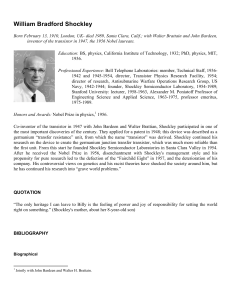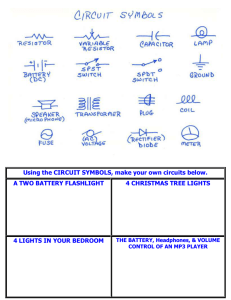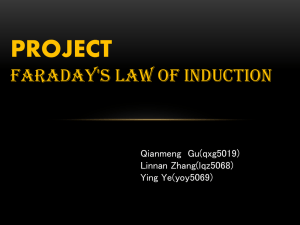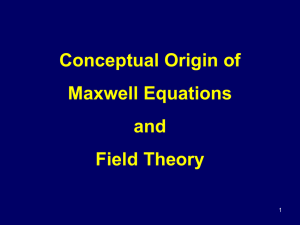Electricity - SWF U3A Home Page
advertisement
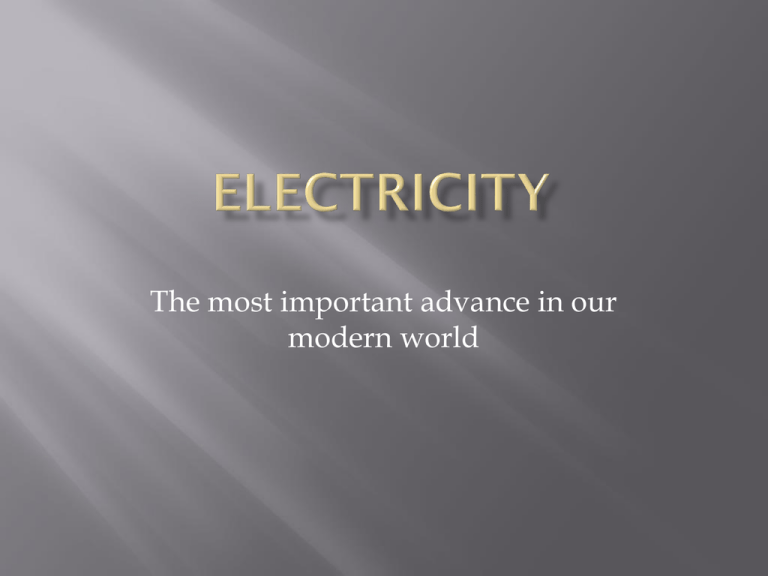
The most important advance in our modern world No telephone, telegraph, radio, television or computers No lighting other than that produced by burn something No cars busses or trains No central heating No music in our homes Almost no industrial output No advanced medical monitoring and diagnostics Distribution of food and goods at a near standstill Heating Magnetic Chemical Newton took control of The Royal Society. Head of demonstrations Frances Hauksbee demonstrates a blue glow by placing his hand close to an revolving evacuated glass sphere. Elizabeth 1 the first marvelled at static electricity's power to lift feather. Stephen Grey at Charterhouse charged up a boy and his hand picked up gold leaf and feather. This led to him realising that electricity could travel through some things and not other. He called them conductors and insulators. Grey could not store electricity Professor Pieter van Musschenbroek in Leiden Holland, discover the Leyden jar for storing electricity. The equivalent of the capacitors we use today. Benjamin Franklin set out to explain lightning and designed experiments to prove his theories. Later invented the lightning conductor Georges-Louis Leclerc and Thomas-François Dalibard conducted Franklins experiment and stored a charge in a wine bottle acting as a Leyden jar. Benjamin Franklin solve the problem of the Leyden jar Henry Cavendish made an artificial Torpedo fish using Leyden jars but the real fish did not produce a spark. Leyden jar high voltage low charge fish high charge low voltage. Fish produces about 240 volts. Ten times less than the Leyden jar. He published very little but some years after his death Maxwell read his papers and realised he had actually discovered much that others had been given credit for Luigi Galvani said that the body worked through body electricity which flowed from the brain to the muscles. Alessandro Volta rejected Galvani and built the Voltaic pile (first battery) to backup his belief. Alessandro Volta studied the structure of the torpedo fish and replicated it in metal to produce the pile. This was the first battery and it was now possible to produce constant electricity. Humphrey Davy built the worlds largest battery in the Royal Institution. It filled a room with over 800 voltaic piles. He connected it to two carbon electrodes and when they touched they produce a blindingly bright light The arc lamp. Michael Faraday a 20 year old book binder enters the Royal Institution. Faraday got a ticket to see one of Sir Humphrey Davys last lectures and that changed his life. Faraday became assistant to Royal Institution Oersted discovered that if you pass an electric current through a wire it will deflect a compass needle Faraday demonstrated circular motion Faraday designed the first dynamo William Sturgeon (Britain) and Joseph Henry (America) invented the electro magnet Ohms law published by Geog Simon Ohm R =V/I V=IR I=V/I First Transatlantic telegraph cable The first message of 98 words took 16 hours to send Cable soon failed when a British engineer thought it would work better at a higher signal voltage A new successful cable was laid in 1866 1n 1864 published his theory that light was an electromagnetic wave after he measured the speed electricity travels is the same as the speed of light Developed the Maxwell equations which explained many of Faradays theories' Edison and Swan formed the Swan Edison Company Edison lit the financial district of New York with his DC system and underground cables The young German physicist Heinrich Hertz is remembered as the first person to detect radio waves, and in doing so he also proved that Maxwell's calculations and theories were all correct. Tesla invented AC motors and designed AC transmission systems Westinghouse were nearly crippled by high royalties on Tesla’s patents so Tesla came to a settlement with them The battle of the currents also almost ruined Edison and the AC system finally won the day over his DC system Did Marconi invent the radio? What he did was to turn the research work of Maxwell, Hertz, Righi, Lodge and others into a practical and commercial communications system In 1909 he shared the Nobel Prize for Physics, with Professor Karl Braun John Bardeen William Shockley Walter Brattain 23 December 1947 demonstration at Bell Labs of the first point contact transistor Augusts 1948 Herbert F. Mataré and Heinrich Welker announced the transistron July 4, 1951 Shockley announced the junction transistor January 1954 first silicon transistor In 1956 John Bardeen, Walter Houser Brattain, and William Bradford Shockley were honoured with the Nobel Prize in Physics Robert Noyce and Jack Kilby independently invent the integrated circuit Ted Hoff's invention of the microprocessor At a critically low temperature certain materials become superconductive and have no electrical resistance. The phenomenon was discovered by Heike Kamerlingh Onnes in 1911 Bardeen, Cooper and Schrieffer proposed the complete microscopic theory of super conductors in 1957 and were later awarded the Nobel Prize. Bardeen is the only physicist to have been awarded two Nobel Prizes as he shared the award for the invention of the transistor in 1956 In 1986, a new compound was discovered that broke the theoretical temperature limit that the theory (known as BCS theory) predicted for superconductivity. It had to be working in a different way. We are still waiting for a brilliant mind to come along and explain John Bardeen Sustainability Alternative power sources The nuclear debate Thinking the unthinkable
